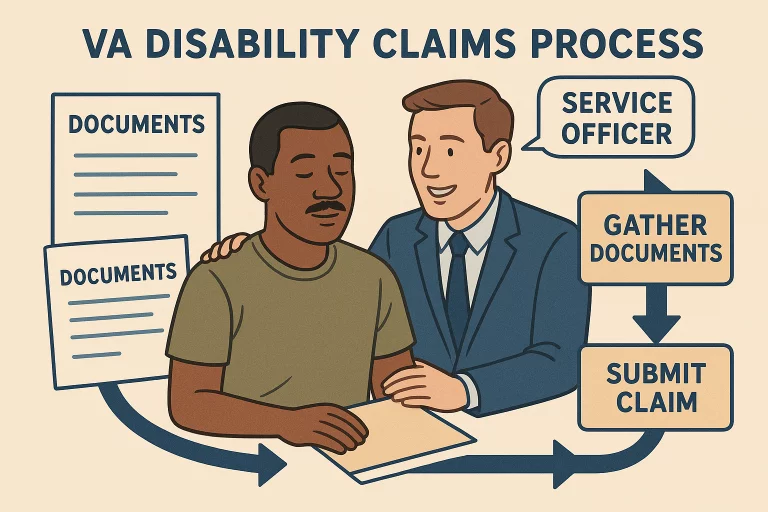Key Takeaways
- Understanding the VA disability claims process improves outcomes for veterans and their families.
- Leverage trusted resources, including Veteran Service Officers (VSOs) and expert advisors, to navigate the system.
- Being mindful of common errors and procedural updates helps prevent unnecessary delays or denials.
Introduction to VA Disability Benefits
Securing VA disability benefits can often feel overwhelming for many veterans, but with the right knowledge and approach, the process becomes much more manageable and less intimidating. Navigating the system is not just about submitting forms; it also means understanding the requirements and preparing thoroughly for every stage. For many veterans, the application process is unfamiliar territory, and small mistakes can have major consequences. Early on, seeking professional assistance with VA disability claims can help veterans avoid common missteps, ensuring that their claims are complete and accurately reflect the conditions they experience as a result of their military service. Veterans can increase their chances of receiving benefits by utilizing expert resources and support networks. The claims process can be complex, involving intricate paperwork, lengthy waiting periods, and frequent updates from the VA. Misunderstandings can lead to delays or denials of benefits. Familiarizing veterans with each step and using available resources can streamline their path to approval. This not only saves time but also ensures their applications accurately reflect their service-related needs and the impact on their lives.
Understanding VA Disability Benefits
VA disability benefits provide financial support to veterans who suffer from service-connected injuries or illnesses. These benefits help offset the impact of these disabilities on a veteran’s ability to maintain employment, support their families, and maintain a high quality of life. The VA evaluates claims through a rigorous process that considers medical evidence, service records, and the connection between the veteran’s disability and their military time—the VA rates medical conditions based on their impact on daily functioning and employability. Understanding the VA’s process is crucial for a successful application and ensuring eligible veterans receive compensation that accurately reflects their service-connected conditions.

Steps to File a VA Disability Claim
1. Gather Necessary Documentation
The first and often most critical step in filing a VA disability claim is gathering all necessary documentation. This includes comprehensive medical records that detail the onset, severity, and ongoing treatment of the condition in question. It is also essential to collect service records that can highlight specific assignments, deployments, or exposures that may have contributed to the disability. Statements from fellow service members, often referred to as “buddy statements,” can further strengthen a claim by providing firsthand accounts of an incident or condition. By assembling a thorough portfolio of evidence, veterans can demonstrate the service connection required by the VA for approval.
2. Complete the Application
Next, veterans need to accurately fill out VA Form 21-526EZ, “Application for Disability Compensation and Related Compensation Benefits.” When completing the application, it is important to explicitly list all disabilities for which compensation is sought, ensuring that each condition is supported by robust documentation. Double-checking for errors, omissions, or discrepancies can prevent delays or misunderstandings once the claim is reviewed.
3. Submit the Claim
Once the application is complete, there are several options for submission. Claims can be submitted online via the VA’s eBenefits portal, which is generally the fastest method and allows veterans to monitor the progress of their claim in real time. Alternatively, claims can be mailed or delivered in person to a local VA office. Regardless of the chosen method, ensuring that copies of all paperwork are retained for personal records is crucial.
4. Attend Medical Examinations
Following submission, the VA may schedule Compensation and Pension (C&P) examinations to assess the severity and likely causes of each disability. During these exams, veterans must be honest, detailed, and proactive in communicating the full impact of their conditions. These examinations play a significant role in the decision process, as the VA uses the findings to determine disability ratings and compensation amounts.
5. Await Decision
After all necessary documentation and exam results are submitted, the VA will review the claim. This review process may take several months, depending on the case’s complexity, the severity of the conditions, and the current backlog at the regional office. Veterans are then notified of the decision via a formal letter, which details the awarded benefits or provides clear reasons in case of a denial. Understanding the reasoning behind the decision is crucial, especially if further action, such as an appeal, is necessary.
Utilizing Veteran Service Officers
Veteran Service Officers (VSOs) are trained advocates who assist veterans in securing their VA benefits. They guide them through the VA disability process, from gathering evidence to interpreting regulations. VSOs are often employed by veteran organizations and are generally available at no cost. By working closely with VSOs, veterans can increase the likelihood of a successful claim by ensuring all required evidence is submitted, prioritizing conditions based on severity, and providing support during appeals or communication with the VA.
Appealing a Denied Claim
VA offers multiple opportunities for veterans to appeal denials or lower-than-expected ratings. Veterans can submit new or additional evidence, request a Higher-Level Review, or file a Notice of Disagreement (NOD) to move the case to the Board of Veterans’ Appeals for in-depth review. The appeal process involves additional forms, potential medical evaluations, and legal arguments. Due to the high stakes, time-consuming, and stressful nature of the process, many veterans turn to Veterans Service Officers (VSOs) for assistance.



